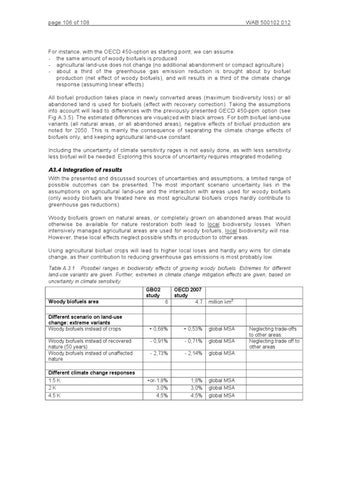page 106 of 108
WAB 500102 012
For instance, with the OECD 450-option as starting point, we can assume: - the same amount of woody biofuels is produced - agricultural land-use does not change (no additional abandonment or compact agriculture) - about a third of the greenhouse gas emission reduction is brought about by biofuel production (net effect of woody biofuels), and will results in a third of the climate change response (assuming linear effects) All biofuel production takes place in newly converted areas (maximum biodiversity loss) or all abandoned land is used for biofuels (effect with recovery correction). Taking the assumptions into account will lead to differences with the previously presented OECD 450-ppm option (see Fig A.3.5). The estimated differences are visualized with black arrows. For both biofuel land-use variants (all natural areas, or all abandoned areas), negative effects of biofuel production are noted for 2050. This is mainly the consequence of separating the climate change effects of biofuels only, and keeping agricultural land-use constant. Including the uncertainty of climate sensitivity rages is not easily done, as with less sensitivity less biofuel will be needed. Exploring this source of uncertainty requires integrated modelling.
A3.4 Integration of results With the presented and discussed sources of uncertainties and assumptions, a limited range of possible outcomes can be presented. The most important scenario uncertainty lies in the assumptions on agricultural land-use and the interaction with areas used for woody biofuels (only woody biofuels are treated here as most agricultural biofuels crops hardly contribute to greenhouse gas reductions). Woody biofuels grown on natural areas, or completely grown on abandoned areas that would otherwise be available for nature restoration both lead to local biodiversity losses. When intensively managed agricultural areas are used for woody biofuels, local biodiversity will rise. However, these local effects neglect possible shifts in production to other areas. Using agricultural biofuel crops will lead to higher local loses and hardly any wins for climate change, as their contribution to reducing greenhouse gas emissions is most probably low. Table A.3.1 Possibel ranges in biodiversity effects of growing woody biofuels. Extremes for different land-use variants are given. Further, extremes in climate change mitigation effects are given, based on uncertainty in climate sensitivity. GBO2 study Woody biofuels area Different scenario on land-use change: extreme variants Woody biofuels instead of crops
Woody biofuels instead of recovered nature (50 years) Woody biofuels instead of unaffected nature Different climate change responses 1.5 K 2K 4.5 K
6
OECD 2007 study 4,7
million km2
+ 0,68%
+ 0,53%
global MSA
- 0,91%
- 0,71%
global MSA
- 2,73%
- 2,14%
global MSA
+or-1,8% 3,0% 4,5%
1,8% 3,0% 4,5%
global MSA global MSA global MSA
Neglecting trade-offs to other areas Neglecting trade off to other areas
